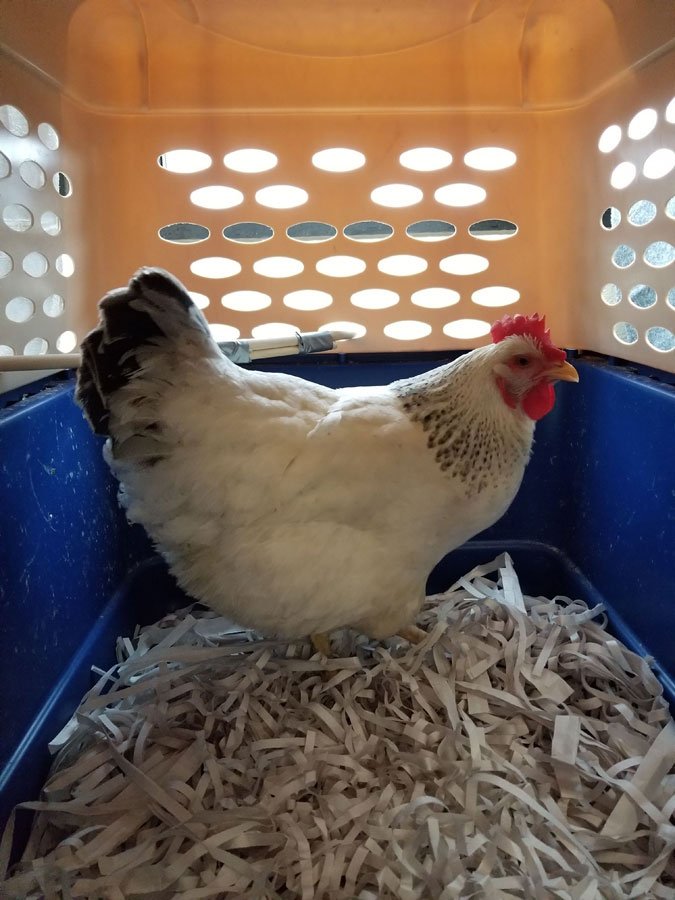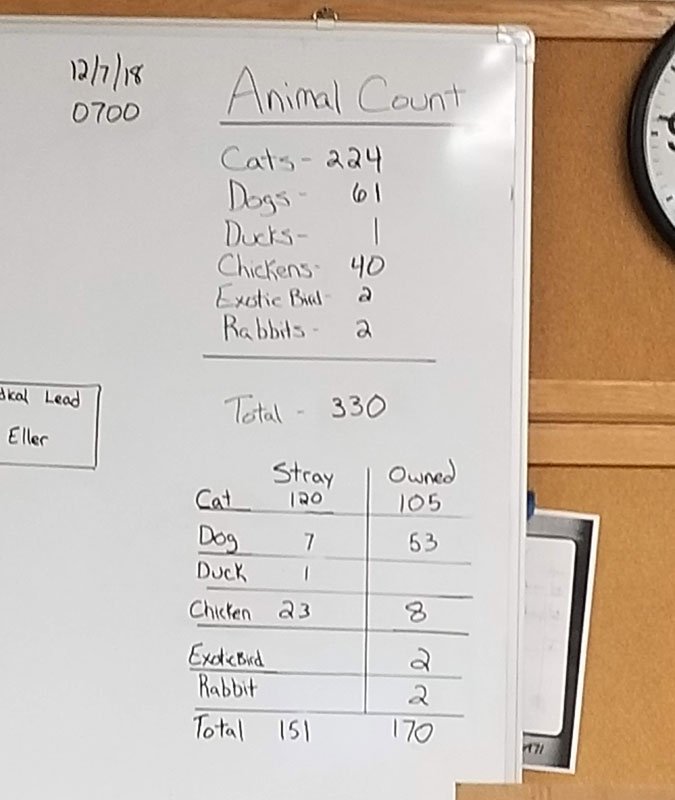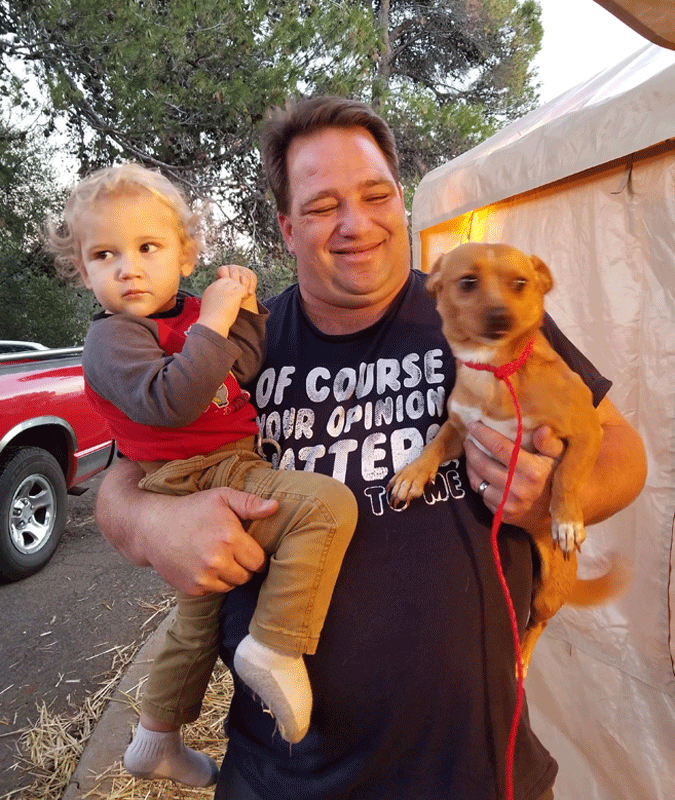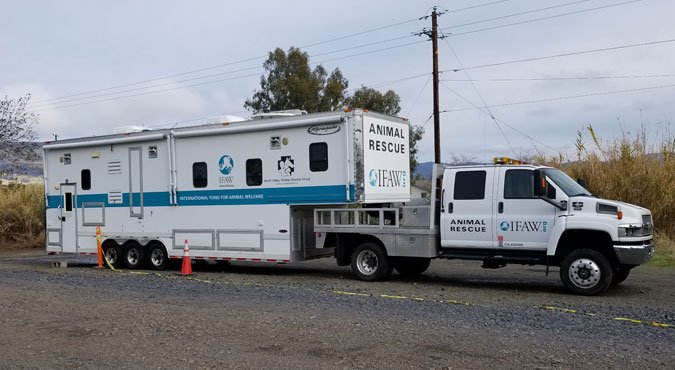I haven’t mentioned the aftermath of the Camp Fire for a while. Between getting the February dry dog food review done, the February issue to the printer, and what has turned into weekly visits to the UC Davis Veterinary Medical Teaching Hospital with some or just one of the foster puppies I’ve been caring for, I haven’t spent very much time at the temporary “shelter” where animals from the Camp Fire were being held. Here’s an update.
At the peak of the Camp Fire emergency, over 2,000 animals were in temporary shelters in a number of locations. This included large animals – horses, donkeys, cows, goats, sheep, pigs, and llamas – who were all taken to a local fairgrounds, where they were held in pens much like any they had ever been held in. I’m sure they experienced some anxiety, but given that their feed and housing was not much different than what most of them had experienced before, I would hazard a guess that they were more or less none the worse for wear.

I’d guess the same could be said for the barnyard poultry: hundreds of geese, ducks, and chickens who were also evacuated or rescued from the fires. Lots of these birds were held temporarily at the shelter where I spent the most time volunteering, and they all seemed mentally and physically just fine, even the ones being held in crates in the medical treatment rooms while under treatment for injuries or illness.
I cannot say the same for the dogs and cats. The household pets were either surrendered by owners who had no means or place to keep them, or were rescued from the fire or fire evacuation zone. They were saved from death in the fire and from starvation and exposure in the weeks following the fire, when the area was still under mandatory evacuation due to the hazards presented by downed trees and powerlines. We could call them the lucky pets – an enormous amount of work and money and love was poured into their care, by literally hundreds of volunteers over the past two months since the fire erupted. But we could also accurately describe them as victims, both of the fire and of their internment in the shelter being managed for their benefit.
One of the ironies of sheltering animals is that while it’s all done for the animals’ benefit, it may be quite unpleasant for them, and perhaps even hazardous to their mental, emotional, and in some cases, even physical health. In the temporary shelters, the dogs were all housed in crates, mostly the wire, folding-type crates. Volunteers walked the dogs at least twice a day, perhaps three times in a day on the days when a lot of volunteers were present, but each walk might be just a few minutes long, especially on the days when volunteers were in short supply.

There were some dogs who were more or less content to hang out in their crates in between their two or three walks per day, but many more were stressed and miserable. There were just too many dogs in too-close proximity to each other, in strange surroundings, with strange people milling in and out, and the food and the schedule was different every day.
There was never enough bedding to make the dogs really comfortable – and in many cases, when you did put a ton of bedding in a crate, dogs would either spill their water all over it, soil it because there had been too much time between potty breaks, or chew it up. Early on in the disaster, there was one person in particular who kept telling the people who were walking the dogs and cleaning their cages to forget about blankets or bedding. “This is just temporary,” he’d insist. “They don’t need it!”
One of the tasks he had taken on was carrying the big plastic bags of sodden and chewed bedding out of the buildings where the dogs were being held. I asked him about the wet and soiled bedding. “Where does it get washed?” I asked naively. It turned out that it was all being thrown away. Yes, hundreds and hundreds of donated pet beds, blankets, and towels were thrown away weekly, because there was no system/infrastructure in place to do pet laundry.
Dogs who were particularly stressed tended to bark all day, or at least every time a person entered the room, and bark constantly while volunteers were present – and this stressed the other dogs and volunteers alike.
On the other hand, there weremany pets (dogs and cats alike) who were given badly needed flea treatments; put on medication for everything from heart conditions to diabetes; had their ears cleaned, nails trimmed, and wounds treated; and so on. I had to hold onto this bit of good news to keep the sad and bad news from overwhelming me.

Many volunteers formed strong relationships with the animals in their care, and the information sheets/care logs on the front of each dogs’ crate started to sprout notes like, “If this dog is never claimed by an owner, I would like to adopt him” and “I would like to foster this dog!” – complete with names and phone numbers. It became a very sore point with many of the volunteers that they were forbidden by “the rules” to contact the dog’ owners (if known), to let them know how the dogs were doing.
Then an even more ridiculous rule was communicated: People who had brought their animals to the temporary shelters were not allowed to visit the animals. When I (and many other volunteers) heard this communicated as a policy, I was incredulous. How cruel! It’s bad enough that people lost their homes and were staying in shelters or their cars or at the homes of friends, but they also couldn’t see or comfort their pets, or receive comfort from them? The rationale cited: “Liability.” WHAT?
Worse yet: If people came to the shelter to look for pets who may have been rescued, they were told to look on the website that was being constructed (by yet more volunteers!) to see if they could identify their pets by photo. If, after they had done that, they thought one or two pets were theirs, they were supposed to come back with the ID numbers of those pets, and someone would bring the pet/s out to show them. I also considered this insane and cruel. We had lots of volunteers who could show them around! What was the harm in letting people look at the animals in person?? Supposedly, again, the rational given was “liability.”
Liability was also the reason given for the rule regarding the qualification of volunteers. Initially, only people who were part of the North Valley Animal Disaster Group (NVADG) and had been through one of NVADG’s courses for volunteers were supposed to be allowed on the emergency shelter sites. Then the word spread that you could also volunteer if you had registered through a local volunteer agency. The agency was supposed to be screening potential volunteers, “swearing them in” (everyone was supposed to take an oath and swear to follow rules and accept responsibility for the potential dangers of volunteering with animals), and assigning them to duties that matched their abilities. Several of my friends, trying to follow the new rule, contacted the agency and asked to register. Each was told, “We are swamped with applications, we will get back to you.” Most never received a call back.
It quickly became understood that the best way to volunteer was to show up with anyone who had been there previously, who would subtly coach you in the art of signing-in, writing your name on a piece of duct tape (Sharpies and duct tape were there on the table with the sign-in sheets), and entering the facility with a confident air. Once on the property, then someone who had more experience could show you where everything was: dogs, leashes, poop bags; where to dump wet bedding and get clean bedding; where we could walk the dogs and where was off-limits, etc.
In the first two weeks of the disaster, as the air grew dark grey and foul to breathe, the NVADG volunteers were running the shelters and doing the lion’s share of the work to care for the animals. As the event wore on, some of the national animal welfare organizations sent people who had years and years of experience with animals in disaster areas. The International Fund for Animal Welfare (IFAW) sent people who provided critical organizational leadership at the shelter site in a town just north and west of the fire (Chico). The American Society for the Prevention of Cruelty to Animals (ASPCA) sent about 10 or 12 people, who worked 12-hour days for 14 days straight at the emergency shelter site in my town (Oroville), similarly taking over organization of the shelter site and volunteers alike. I heard about, but never met, people who came from the Humane Society of the United States (HSUS) and other organizations.
During the stretches of time that these experienced people were on site, things started to feel more sane. They redacted some of the nonsensical rules that had been imposed, including the rules against allowing visits from owners who had left their pets at the shelter and allowing people who were looking for their pets to come through and look at all the animals. They modeled more compassionate interactions altogether. When fire victims and evacuees would thank them (or other volunteers) for their help, they would always say, “It is our honor to help you. We know you have gone through so much. Please let us know if there is anything else we can do for you.”
They also welcomed every person who showed up to volunteer and found something for every person to do. “No experience with cats? Could you sort these donated blankets and towels, and fold and stack them in these containers in separate piles?” (This was a huge help for the people who were cleaning cages, to be able to come and grab armloads of the right type of bedding in just a minute, instead of having to grub through piles and locate appropriate things.) “What do you do? A software engineer, you say? Could you help with some Excel spreadsheets that will help us track which animals are in various parts of the facility?” Strong people were put to work unloading and organizing donations of pet food, kitty litter, and crates. Fast people were given jobs running all over the facility, passing messages and carrying supplies.
It was during this phase of the event that I spotted the litter of starving, mange-covered puppies that had been brought into my local shelter. I had gone there to answer a call for people who could help the already beleaguered staff move a lot of donated goods from an outdoor location into shipping containers that had been rented for extra temporary storage. As I recounted in an earlier post, the sight of this pathetic bunch just broke something inside me; I felt strongly called to help them, especially since I thought it was highly likely they would be lost in the bigger, more dramatic emergencies going on with the fire victims and evacuees. With my hands full taking care of these pups, and with the ASPCA folks on site, I stepped away from volunteering at the temporary shelter…
…And almost immediately started getting reports from friends who were still volunteering that as soon as the ASPCA left, things had started to go downhill at the shelters. Soldiers from the National Guard were brought in and given assignments to help care for the animals. A series of animal control officers arrived from different, out-of-the area locations – San Diego (some 10 hours away), Monterey, Oregon, Texas! – and were put in charge of the shelter. To this day, I’m not sure how these selections or assignments were made, or whether it was up to our county animal control department, the California Office of Emergency Services (Cal OES), or the Federal Emergency Management Administration (FEMA), but I know that each of these organizations had staff working involvement in the oversight of the event. And while each change of leadership brought competent, caring people to our community, the weekly changes in policies and practices exhausted and discouraged volunteer after volunteer. One by one my friends and acquaintances stopped volunteering.
Well, the number of animals in the shelters was slowly reducing anyway, as owners reclaimed or found their pets – and after the county animal control department finally permitted volunteers to contact known owners and arrange for foster care of some of the animals whose owners were known. As I write this, a little more than two months since the fire started, the last of the temporary emergency shelters began closing up shop. The last animals, including some 37 unclaimed dogs and more than 350 cats, have been sent to a number of local shelters (including the one where I ordinarily volunteer). It’s up to the shelters as to whether they continue to hold the animals apart, in hopes that their owners still might show up, or to adopt or allow people to foster the animals.
Dog Safety Takeaways from After A Natural Disaster
What are my takeaways from all this?
- Microchip your animals, and keep the registration/contact information current. Chipped animals are the first to be identified and returned to their owners.
- If there is any natural disaster coming your way, keep your pets close. Don’t leave without them, if possible.
- If your pets are separated from you after a disaster, keep checking every place where rescued animals have been taken – daily, if you can. Get them out of temporary holding facilities as soon as you possibly can.
- If you have no place to go with your pets, try to arrange for one of your friends or family members to foster or care for your pets.
- I’m sure there is more, but this is what the experience has engraved on my brain.
Thanks to all of you who sent donations to either NVADG or my local shelter, the Northwest SPCA. The extra support has come in handy, as all the local shelter are full to the brim right now. And thanks to all the hundreds of volunteers who have helped care for these animals.





